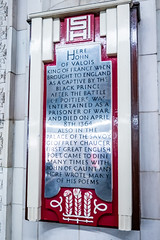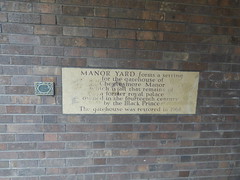Edward of Woodstock


Edward of Woodstock
(1330-1376)
Black Prince, 1st Duke of Cornwall (1337-1376), Prince of Wales (1343-1376), and Prince of Aquitaine (1362-1372)
Family tree
Commemorated on 4 plaques
Here John of Valois King of France when brought to England as a captive by the Black Prince after the Battle of Poitiers, was entertained as a prisoner of war, and died on April 8th 1364. Also in the Palace of The Savoy, Geoffrey Chaucer first great English poet, came to dine many times with John of Gaunt, and here wrote many of his poems
Savoy Court, WC2R 0ET, London, United Kingdom where they held the King of France captive
Manor Yard forms a setting for the gatehouse of Cheylesmore Manor which is all that remains of a former royal palace owned in the fourteenth century by the Black Prince. The gatehouse was restored in 1968.
Manor Yard near New Union Street, Coventry, United Kingdom where they owned
Cheylesmore Manor House A manor house at Cheylesmore is first mentioned in the year 1250. In 1320 it passed to Queen Isabella. wife of Edward II. and from her to her grandson, the Black Prince. In 1385 the royal manor was enclosed within the city walls, then under construction. In the 16th century Leland wrote, "the King has a palace at Coventry now somewhat in ruin. The great hall was said to be down. In 1661 its other buildings were repaired by Sir Robert Townsend. In 1738 a weaver asked permission to make a tenement of one of them! In 1955 most of the South wing, which had become a range of industrial top-shops, was demolished. In 1965 Coventry Corporation undertook restoration of the gatehouse and the surviving bays of the north and South wings. The work. completed in 1968. revealed important historical features. For example. the south wing probably belongs to the original manor house of the 13th century: the ogee-headed doorway (on right) is an original entrance into the manor grounds from the Grey-Friars Monastery of which only the church steeple still stands: the open timber roofs had scarcely been altered since they were built; and of the original framework enough had survived to assure authentic restoration.
Coventry Register Office, Manor House Drive, Coventry, United Kingdom where they owned (1357-1375)
Le Château Vieux Construit Sur Lemplacement Du Castellum Romain Par Bertrand Vicomte De Bayonne A Ete Habite Par Don Alfonso Le Batailleur Roe De Navarre (1130) Le Prince Noir + Duguesclin Don Pedro Le Cruel Roi De Castille (1367) Louis XI (1463) Francois Ier (1526) Charles IX (1565) Louis XIV (1660) Marie Anne De Neubourg Reine D'espagne (1706) Let Le General Palafox Defenseur De Sar Agosse (1809)
English translation: The Old Castle Built on the site of the Roman Castellum by Bertrand Vicomte de Bayonne Has Been Habited By Don Alfonso The Fighter Roe Of Navarre (1130) The Black Prince + Duguesclin Don Pedro The Cruel King Of Castile (1367) Louis XI (1463) Francis I (1526) Charles IX (1565) Louis XIV (1660) Marie Anne De Neubourg Queen of Spain (1706) Let General Palafox Defender Of Sar Agosse (1809) [AWS Translate]
Château Vieux - Rue des Gouverneurs, Bayonne, France where they lived (1366)




